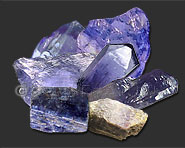TANZANITE INFORMATION

Tanzanites were first found in the late 1960's, at what remains the sole source: a hilly area called Merelani in, Tanzania. Legend says that it was Masai cattle herders that first noticed this stone some 30 years ago after a fire caused by lightening burned areas in Tanzania. The herders noticed that brown zoiscite crystals had turned a deep blue-purple due to the heat from the fire.
The name Tanzanite was given to this stone by Tiffany & Co. in 1969 as a trade name and has stuck ever since. It is usually found in veins of granite schist with calcite, sulfur, quartz, and green garnet. Tanzanite can possess a rich, sapphire blue color (possibly with some violet red or greenish yellow flashes). This lovely gem can cost many thousands of dollars per carat today in larger sizes. But one must be cautious. It is relatively soft, so we do not recommend tanzanite for rings (unless it's set in a very protected setting) or for everyday wear in which it would be exposed to knocks and other abuse. One must also be aware that a very inexpensive, dull, brownish zoisite can become a beautiful, expensive tanzanite after heat treatment.
| CHEMISTRY | Ca2Al3(SiO4)3(OH) |
| CRYSTALLOGRAPHY | Orthorhombic |
| REFRACTIVE INDEX | 1.692 - 1.700 |
| HARDNESS | 6 - 7 |
| SPECIFIC GRAVITY | 3.35 |
| CLEAVAGE | Perfect |
| HEAT SENSITIVE | Yes |
| WEARABILITY* | Good |
| SPECIAL CARE INSTRUCTIONS | Avoid rough treatment |
| ENHANCEMENTS | Virtually all tanzanite is heat treated |
*Wearability is graded as Excellent, Very Good, Good, Poor, and Forget It!
EFFECTS OF LIGHT ON TANZANITE
| TYPE OF LIGHTING | EFFECT OF LIGHTING ON TANZANITE |
| SUNLIGHT | At midday, it normally has a neutral effect on the hue. Earlier and later in the day, it adds red, orange, or yellow making the stones look more purple. |
| LIGHT BULBS & CANDLELIGHT | Add red. Purple colors are strengthened, blue may turn violet to purple, and grayish colors may look brownish. The degrees of change varies depending on the stone. Some show little change. |
| FLOURESCENT LIGHTS | Depends on what type they are. Most strengthen the blue in |
| HALOGEN SPOTLIGHTS | Add sparkle and usually make stones look more purple. The color change is usually less than with light bulbs. |
| LIGHT UNDER AN OVERCAST SKY | Adds blue and grey. |
Few gems have attained the popularity of Tanzanite in such a short period of time. Tanzanite is a beautiful gem, but with moderate hardness and perfect cleavage, it is less than ideal for wearing in jewelry. Its closest look-alike, iolite, wears much better and costs less. Therefore, much credit has to be given to a world-class promoti of this gemstone.
The source for tanzanite is one small area in Tanzania. All the upper layers have been worked and the latest sources are from substantial depths. The mines closed right after the 1998 Tucson show. Heavy rain, flooding, and cave ins caused several dozen deaths.
To reopen the mines requires considerable reinforcement. None of the local miners will go back into the holes, so a foreign crew would have to be brought in. Several large corporations have looked into taking over the mines, but none have attempted it because the cost is too great. Even though the supply diminished considerably, the demand for tanzanite remains high. New sources have been discovered that are somewhat removed from original source. However, the deposits are small and the production is not nearly enough to equal demand. Prices have skyrocketed and are expected to remain high for several years. They will not go down until the demand for this gem finally settles. Since the mines closed, prices have varied wildly.
Tanzanite is a variety of zoisite, which is a member of the epidote group. The particular coloring that distinguishes tanzanite is only found in Tanzania. As it comes from the ground, it is primarily brown, although many stones show some purple. By heating the stones to approximately 700 degrees Celsius, a pleasurable color change takes place.
The quality of rough can be evaluated by its tone, (its relative lightness or darkness.) The tone doesn't change during heating; it just goes from brown to purple and blue. So the darker the tone before heating, the higher quality your finished goods will be.
After heating most tanzanites are just purple, with approximately 1/3 of the pieces showing blue in one direction. About half of these will be oriented so you can get maximum yield cutting for the blue color, or about 1/6th of each lot. Every once in a while you will also find a very rare green tanzanite. Blue tanzanites are more desirable than the purple. Before the primary mines closed, they brought a higher price. Now the distinction between blue and purple gems no longer has a substantial affect on the price.
In October 2002, Tanzanite was added to the official birthstone list by the American Gem Trade Association as an additional birthstone for December. Because this is such a new gemstone, there is little folklore or healing properties surrounding this stone.
Tanzanite has rapidly become the most desired colored gem in the United States. High demand and very limited supply has caused prices to take dramatic leaps over the last two years. Color is what has caused women to be mesmerized by this gem. The finest gems have a vivid blue to violet color which is significantly influenced by the ambient light. Daylight will cause this gem to show blue and incandescent light will bring out the violet color. The future of this gem can be predicted; greater demand and high prices.
or call us: (April 1st - September 26th) 570-925-4419
(October 1st - March 27th) 828-837-6860
cell phone - 570-912-8407